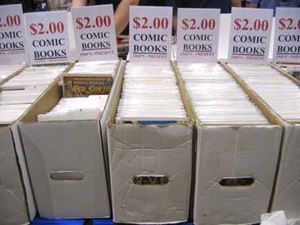- Comics
- Comics Reviews
- Manga
- Comics Reviews
- European Comics
- News
- Comics News
- Press Releases
- Columns
- Spotlight
- Digital Comics
- Webcomics
- Cult Favorite
- Back Issues
- Webcomics
- Movies
- Toys
- Store
- More
- About

By Philip Schweier
August 12, 2015 - 12:24
DISCLAIMER:
This article is way overdue, and my excuse is that my computer ate my homework.
I suffered a catastrophic failure of my hardware, and it’s taken me a few weeks
to get up to speed. My data was recovered, but due to limited space, I’ve spent
the past week and half combing through all an alphabet soup of JPGs, DOCs, PDFs
and other files, pruning, culling and harvesting.

I know my readers (both of them) don’t really care about excuses. I’d just rather head off any questions ahead of time.
And now, back to our regularly schedule essay.
Recently, a friend asked me to search my bookshelf for a particular series that came out in the mid-1980s. Kidding around, I said I would check my archives, which is what I laughingly call the many boxes of comic books stored in my closet. He then commented, “I figured you’d have the trade paperback (TPB),” knowing that many “serious” comic book fans prefer the collected editions, but I indicated I preferred the single issues over trades.
Mrs. Wife caught this exchange, and later asked why I prefer the single issues over trades. She lovingly indulges my interest in comics (she goes so far as call it an obsession; funny girl). When I’m dead and buried, it will be her sad task to dispose of my archives in such a way that doesn’t involve a can of gasoline and a match. So safe to say she has a vested interest.
So here’s my reasoning:
In the past, many
collectors believed that their “archives” would accrue in value over the years,
as some issues became more in demand. However, since the advent of the trade
paperback, many of those originals have become redundant. Some have to weigh
the merits of buying individual issues from multiple online sources versus
buying the TPB for a fraction of the cost.

I once believed my comic books were an investment. If I took care of them, they’d be valuable someday, and would finance my retirement. Uh-huh. You really think that after a lifetime of collecting, I’d part with them just so I can live in a slightly better nursing home? Doubtful.
To me, the collection is not a cash cow. They are entertainment. Some hold a greater interest than others due to who wrote them or drew them, or the characters they featured. Some are simple, juvenile stories that provide a greater diversion when life becomes a fist.
Trade paperbacks are fine for those who are perhaps very serious about their fandom, but I am not – at all. I’m a comic book collector, not a trade paperback collector.